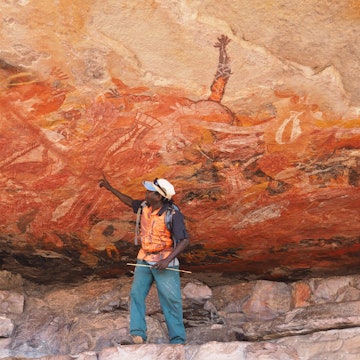

Whether or not you’ve sat through an episode of I’m a Celebrity… Get Me Out Of Here!, you’re probably familiar with the concept of a ‘bush tucker trial’. Since the TV reality show set in the Australian jungle first appeared on screens, the phrase has become synonymous with celebrities being challenged to eat a variety of unsavoury-looking insects and animal parts.
This deliberately unappetising portrayal of bush tucker does the name a disservice, because insects and other food foraged from the bush can be genuinely nutritious and surprisingly delicious. There are Aboriginal communities in Australia who have been living off diets pretty much unchanged for the last 60,000 years, and many experts believe that in the future, as competition for food increases across the planet, insects and bugs may be seen as an increasingly desirable source of protein.

That’s why I’ve come to Kakadu National Park, 100 miles east of Darwin in the far north of Australia, to meet Patsy Raglar. Patsy is an Aboriginal guide with Animal Tracks Safari, and has lived her whole life in Kakadu – which at 20,000 sq km is Australia’s largest national park and home to some 2,000 plant species and a wide variety of birds and other animal life. Today we’re at Anbangbang Billabong, in the shadow of Nourlangie Rock, to see what we can find. Maybe it’s the influence of I’m a Celebrity…, but personally I’m hoping to get a taste of a witchetty grub.
It doesn’t take Patsy long to find a tree crawling with green ants. In one fluid motion she plucks a handful of leaves from the tree, and when she opens her hands I see they are crawling with ants and smeared with ant eggs that look like white caviar. She offers a handful to me to eat, and when I bite into the ants they burst in my mouth with a strong citrus flavour like tiny, powerful lemons.

“We just eat them raw,” explains Patsy. “As they get older the taste gets even stronger. I’ll tell you a little story. Before people had cough medicine like we have today, we would use these ants to cure the flu. Some people still use it. They’re good for headaches too.”
Green ants have become so popular in Australia that even high-end restaurants have put them on their menus. At Tali Wiru, a fine-dining restaurant in Australia’s red centre with spellbinding views of Uluru and Kata Tjuta, they serve gin-and-tonic infused cucumbers garnished with green ants. So don’t complain if there’s a bug on your canapé – everyone will want one.
“Our whole menu is inspired by and based on indigenous ingredients,” says chef Stephen Russell. “Green ants are a beautiful thing. They live in trees and the best way to get them down is to put a fishnet at the bottom and get a big-arse stick and hit the hell out of the tree. As a chef, they’re better than using lemon.”

Back in Kakadu, Patsy is demonstrating how to strip a paperbark tree in order to make a basket and then how to fill it with foraged fruit and vegetables. She collects Kakadu plums, a small green fruit with a tart taste and the highest vitamin C content of any fruit or vegetable in the world. Eating 100g of a Kakadu plum is about as good for you as eating 80 oranges. Next in the basket is Patsy’s personal preference when it comes to bush vegetables. “My favourite food is the long yam,” she says. “They’re called that because they grow a long way down in the ground, not because they are long. We don’t plant them, we just find them in the bush and then dig them up and cook them in the fire.”
As well as honing a sharp eye for which plants and insects are edible, Patsy is also keenly aware of the uses of poisonous plants. She points out a type of tree she calls an ‘itchy bush’, which is also known as the fish poison tree. When the plant’s sap is released into an enclosed body of water, it has the same effect on fish as if you’d put plastic over their gills. “People a long time ago didn’t have any fishing lines to get fish, so they’d use this instead,” explains Patsy. “Afterwards you’d see the fish coming up, even big fish like barramundi. They’re paralysed so they stop swimming and you just go and pick them up.”

Soon enough Patsy’s collected enough food for us to have a hearty lunch of barramundi and yam, cooked in the coals of an open fire. She explains that a typical day in the bush would involve spending the morning walking and collecting food. Then at around two or three in the afternoon they’d make a fire like this, sit and cook their food. That would be their main meal of the day. By four or five they’d be finished and they’d return to camp. It is considered dangerous to cook at night as it can attract animals and even evil spirits to the camp. Nighttime is for dancing, singing, telling stories and sleeping.
I’m a little disappointed we didn’t find a witchetty grub, but as we start to leave the billabong Patsy catches sight of a tree with a tiny telltale mound of sawdust near the base. Taking her axe to the roots, in moments she reveals the hollowed-out home of a solitary grub, fat and white and soon wiggling between her forefingers. She offers it to me and I take a bite: it tastes great, like prawn and peanuts. If we all end up eating more bush tucker in the future, then you could do a lot worse than a plate of grubs. Meanwhile, somewhere in the outback, a kangaroo breathes a sigh of relief.













